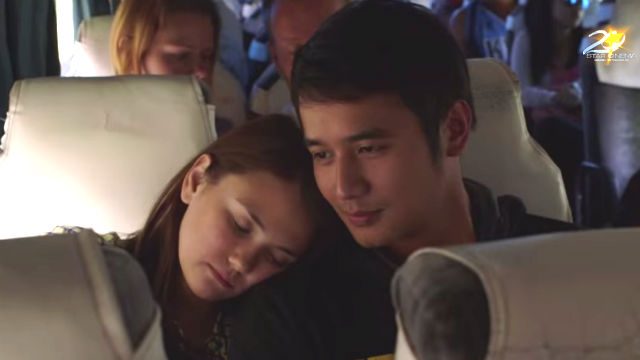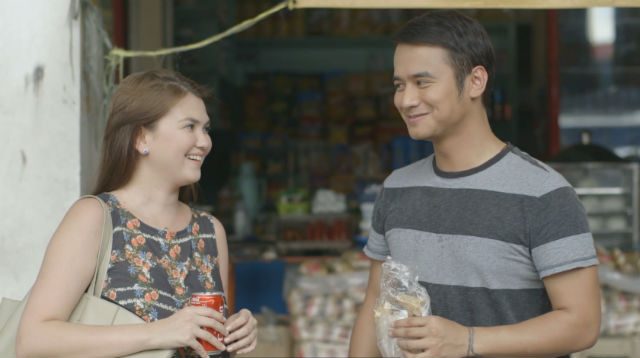SUMMARY
This is AI generated summarization, which may have errors. For context, always refer to the full article.

Two strangers meet under embarrassing circumstances in a foreign airport. The boy had his heart broken many years ago and has moved on. The girl’s in a more urgent situation, since she is on her way back to the Philippines after a break-up that has reduced her to a teary-eyed mess. (READ: Valentine’s 2015 at the movies: ‘Fifty Shades,’ Kathniel, and more)
The two failed romantics embark on an impromptu journey that force them to share previous experiences and new ones, hoping that each other’s companies would alleviate their respective heartaches.
Antoinette Jadaone’s That Thing Called Tadhana relishes the simplicity of its premise. It never strays towards the unlikely situations that most romantic comedies rely on for pageantry. The film keeps its feet firmly grounded within the realm of reality.
With convincing performances from Angelica Panganiban and JM de Guzman, the film effortlessly evokes both the palpable pain of losing love and the alluring pleasure of gaining it back.

Pop princess
That Thing Called Tadhana cements Jadaone as one of this generation’s most exciting filmmakers. In fact, it will not be far-fetched to even claim that Jadaone, with her distinct affinity with a genre that has been used and abused by studios for indiscriminate profit, could be the one person that could uplift commercially intentioned cinema from the pits of obscurity.

What Jadaone brings to the fore is not her trademark wit or filmmaking skills. It is her sincerity. She is an unabashed child of the ’90s; a follower of Regine Velasquez’s cinematic love affairs, a consistently curious advocate of the kinks and quirks that defined the pop era.
This shows in all her films. Strangely, the references do not feel forced or just for show. They do not bear the glaring and grating parade of the famous movie lines often quoted for jest in a lot of the inane comedies of today.
Jadaone’s references come from a more sincere source, something akin to generosity towards pop culture that has been unfairly criticized for its whims and fancy, or to sheer gratitude.
For example, Jadaone’s first feature film, Six Degrees of Separation from Lilia Cuntapay (2011), is not so much an experiment that mixes fictional and documentary elements to create an elaborate mock on pop, but a belated tribute to a nearly forgotten icon.
Intriguingly, Jadaone never forgets that her goal as a filmmaker is still to entertain and this motivation is clearly marked in the feature.
Unmistakable wit
It is indisputable that part of Jadaone’s arsenal of tools as an effective filmmaker is her unmistakable wit. Her short films like Saling Pusa (2006) or Tumbang Preso (2008) already featured characters that had the plucky quality of her future heroines.
Six Degrees has Myra, played by Geraldine Villamil, who counterpointed Cuntapay’s unsullied expectations with humorous sarcasm. All the three women of Beauty in a Bottle masked their insecurities with comedic blather. Relaks, It’s Just Pag-Ibig’s severely underrated Cupcake has the makings of the perfect antithesis to a Jadaone protagonist, with her near-caricature exemplification of an immature woman so detached from her emotions.

Then there’s English Only, Please’s Tere (Jadaone shares story credits) and That Thing Called Tadhana’s Mace mouth their heart’s despairs with all the sappy eloquence of Regine Velasquez’s character in Joyce Bernal’s Paano Kita Iibigin (2007).
In fact, all of her films owe their style and sizzle to the rom-coms whose predictable romances are forever imprinted in Jadaone’s creativity, and she is amazingly unashamed of it.
Back to ‘Tadhana’
In the end, That Thing Called Tadhana only exemplifies that things don’t always need an overt veil of profoundness to fly. All it needs is a clear path leading to the artist’s soul.
That Thing Called Tadhana exposes Jadaone as a sucker for fairy tales, which have always been the root of the supposedly repetitive romances that screen frequently in local cinemas. It reveals Jadaone as this fervent disciple of the genre, with its weakness for happy endings, which will never fail to create that spectacle of bliss for all lovers, would-be lovers, and once-lovers who can never give up on love. – Rappler.com
 Francis Joseph Cruz litigates for a living and writes about cinema for fun. The first Filipino movie he saw in the theaters was Carlo J. Caparas’ ‘Tirad Pass.’ Since then, he’s been on a mission to find better memories with Philippine cinema. Profile photo by Fatcat Studios
Francis Joseph Cruz litigates for a living and writes about cinema for fun. The first Filipino movie he saw in the theaters was Carlo J. Caparas’ ‘Tirad Pass.’ Since then, he’s been on a mission to find better memories with Philippine cinema. Profile photo by Fatcat Studios
Add a comment
How does this make you feel?
There are no comments yet. Add your comment to start the conversation.